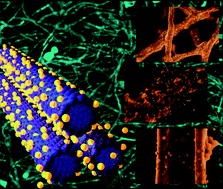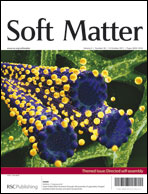We report on the use of binary mixtures of oppositely charged gold nanoparticles (AuNPs) and spherical polyelectrolyte brushes (SPBs), consisting of a polystyrene core onto which long polystyrene sulfonate chains are grafted, as a simple model system to investigate the influence of directional interactions on self-assembly. We demonstrate that the mixing ratio, i.e., the number of AuNPs per SPB, has a profound influence on self-assembly. In particular we report on the formation of giant hollow fibers, and present a thorough characterization of these nanostructures. We speculate that the adsorption of a few AuNPs on the SPBs appears to direct the tubular self-assembly, and discuss the analogy to the case of modified proteins such as tubulin under the action of nucleotides.
You have access to this article
 Please wait while we load your content...
Something went wrong. Try again?
Please wait while we load your content...
Something went wrong. Try again?


 Please wait while we load your content...
Please wait while we load your content...